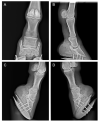Oral Supplementation with Ultramicronized Palmitoylethanolamide for Joint Disease and Lameness Management in Four Jumping Horses: A Case Report
- PMID: 32825646
- PMCID: PMC7552276
- DOI: 10.3390/ani10091469
Oral Supplementation with Ultramicronized Palmitoylethanolamide for Joint Disease and Lameness Management in Four Jumping Horses: A Case Report
Abstract
Background: Four show jumping horses were evaluated for non-responsive lameness, which caused their withdrawal from show jumping competitions. The clinical evaluation was performed by radiographic examination, flexion tests, diagnostic anesthesia and lameness evaluation using the American Association of Equine Practitioners (AAEP) scale. The diagnoses were a case of navicular syndrome, a complicated case of chronic navicular syndrome and arthrosis of the distal interphalangeal joint of the right anterior limb and two cases of distal intertarsal joint arthritis. Nutraceuticals are often an important management strategy or coadjutant of pharmacological therapies in joint disease. Ultramicronized Palmitoylethanolamide (PEA-um) is an endogenous fatty acid amide that is well-known for its anti-inflammatory and analgesic proprieties widely used in human medicine and small animal veterinary medicine. Although it includes a small number of cases, our study describes for the first time the efficacy of the use of PEA-um in horses. The four horses with non-responsive lameness and significant impairment in athletic performance were daily treated with PEA-um into their normal diet. After four months of PEA-um supplementation, all horses showed remissions of lameness that led to their reintroduction into showjumping competitions without disease recurrence. Therefore, despite the small number of cases included in this study, these observations suggest a good prospective for developing a controlled experiment to test PEA in a larger cohort of horses.
Keywords: ALIAmides; hoof pain; lameness; lmitoylethanolamide palmitoylethanolamide; navicular syndrome.
Conflict of interest statement
Salvatore Cuzzocrea is a coinventor on patent WO2013121449 A8, which deals with methods and compositions for the modulation of amidases capable of hydrolyzing N-acylethanolamines employable in the treatment of inflammatory diseases. This invention is wholly unrelated to the present study. Moreover, Cuzzocrea is also, with Epitech Group, a coinventor on the patents EP 2 821 083, MI2014 A001495, and 102015000067344, which are unrelated to the study. The remaining authors report no conflicts of interest.
Figures



Similar articles
-
Intra-articular anesthesia of the distal interphalangeal joint alleviates lameness associated with the navicular bursa in horses.Vet Surg. 1997 Mar-Apr;26(2):137-40. doi: 10.1111/j.1532-950x.1997.tb01476.x. Vet Surg. 1997. PMID: 9068164
-
Evaluation of clinical examination for differential diagnosis of lameness by navicular apparatus or heel pain in horses.Pak J Biol Sci. 2008 Jul 1;11(13):1754-6. doi: 10.3923/pjbs.2008.1754.1756. Pak J Biol Sci. 2008. PMID: 18819633
-
The effects of local anaesthetic solution in the navicular bursa of horses with lameness caused by distal interphalangeal joint pain.Equine Vet J. 2003 Jul;35(5):502-5. doi: 10.2746/042516403775600460. Equine Vet J. 2003. PMID: 12875330
-
Ultramicronized Palmitoylethanolamide (um-PEA): A New Possible Adjuvant Treatment in COVID-19 patients.Pharmaceuticals (Basel). 2021 Apr 6;14(4):336. doi: 10.3390/ph14040336. Pharmaceuticals (Basel). 2021. PMID: 33917573 Free PMC article. Review.
-
Navicular syndrome in equine patients anatomy, causes, and diagnosis.Compend Contin Educ Vet. 2010 Dec;32(12):E7. Compend Contin Educ Vet. 2010. PMID: 23705198 Review.
Cited by
-
Chronic Pain in Dogs and Cats: Is There Place for Dietary Intervention with Micro-Palmitoylethanolamide?Animals (Basel). 2021 Mar 29;11(4):952. doi: 10.3390/ani11040952. Animals (Basel). 2021. PMID: 33805489 Free PMC article. Review.
-
An Evaluation of Current Preventative Measures Used in Equine Practice to Maintain Distal Forelimb Functionality: A Mini Review.Front Vet Sci. 2021 Nov 2;8:758970. doi: 10.3389/fvets.2021.758970. eCollection 2021. Front Vet Sci. 2021. PMID: 34796229 Free PMC article. Review.
-
Dietary Supplementation with Palmitoyl-Glucosamine Co-Micronized with Curcumin Relieves Osteoarthritis Pain and Benefits Joint Mobility.Animals (Basel). 2020 Oct 8;10(10):1827. doi: 10.3390/ani10101827. Animals (Basel). 2020. PMID: 33049960 Free PMC article.
References
-
- Parkes R., Newton R., Dyson S. Is there an association between clinical features, response to diagnostic analgesia and radiological findings in horses with a magnetic resonance imaging diagnosis of navicular disease or other injuries of the podotrochlear apparatus? Vet. J. 2015;204:40–46. doi: 10.1016/j.tvjl.2014.12.038. - DOI - PubMed
-
- Waguespack R.W., Hanson R.R. Treating navicular syndrome in equine patients. Compend. Contin. Educ. Vet. 2011;33:E2. - PubMed
-
- Grewal J.S., McClure S.R., Booth L.C., Evans R.B., Caston S.S. Assessment of the ultrasonographic characteristics of the podotrochlear apparatus in clinically normal horses and horses with navicular syndrome. J. Am. Vet. Med. Assoc. 2004;225:1881–1888. doi: 10.2460/javma.2004.225.1881. - DOI - PubMed
Publication types
LinkOut - more resources
Full Text Sources

